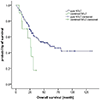Combined Small Cell Carcinoma of the Lung: Is It a Single Entity?
- PMID: 29101056
- PMCID: PMC8057113
- DOI: 10.1016/j.jtho.2017.10.010
Combined Small Cell Carcinoma of the Lung: Is It a Single Entity?
Abstract
Background: SCLC accounts for 15% and 20% of all lung cancers, with combined SCLC (CSCLC) comprising 2% to 5%. Little is known about the clinical characteristics and molecular changes associated with the various histologic components.
Methods: A total of 205 SCLC cases were resected between 2005 and 2015. Clinical and pathologic features were analyzed. All CSCLC cases were confirmed by histologic examination and immunohistochemistry. The individual components were microdissected using a novel automated dissection system, and DNA was extracted and subjected to targeted exome sequencing.
Results: A total of 10 cases of CSCLC were identified out of 170 cases with adequate histologic material; squamous cell carcinoma comprised the second component in half of these (n = 5). There were no significant differences between CSCLC and pure SCLC with respect to clinical features. The median follow-up time was 36 months. The median survival times of patients with pure SCLC and CSCLC were 58 months and 26 months, respectively (p = 0.030). The different components of three cases of CSCLC were deemed adequate for microdissection and sequencing. Approximately 75% of the identified somatic mutations were present in both components. There were also 15 gene mutations or six amplifications unique to only one of the components.
Conclusions: We identified no significant clinical or pathologic differences between pure SCLC and CSCLC; CSCLC was associated with decreased overall survival compared with pure SCLC. The histologic components of CSCLC had high genetic concordance but also showed divergent genotypes. These findings may suggest a common precursor with subsequent acquisition of oncogenic changes in CSCLC.
Keywords: Combined small cell lung cancer; SCLC; Small cell lung cancer; Targeted gene sequencing.
Copyright © 2017 International Association for the Study of Lung Cancer. All rights reserved.
Conflict of interest statement
Disclosure: The authors declare no conflict of interest.
Figures



Comment in
-
Morphologic and Other Forms of Heterogeneity in Small Cell Lung Cancer: What Can We Learn from Them?J Thorac Oncol. 2018 Feb;13(2):148-150. doi: 10.1016/j.jtho.2017.11.004. J Thorac Oncol. 2018. PMID: 29425612 No abstract available.
Similar articles
-
Combined small cell lung cancer: current progress and unmet needs.Am J Cancer Res. 2023 Sep 15;13(9):3864-3874. eCollection 2023. Am J Cancer Res. 2023. PMID: 37818075 Free PMC article. Review.
-
Comprehensive genomic profiling of combined small cell lung cancer.Transl Lung Cancer Res. 2021 Feb;10(2):636-650. doi: 10.21037/tlcr-20-1099. Transl Lung Cancer Res. 2021. PMID: 33718010 Free PMC article.
-
A case of combined small cell lung carcinoma with unique morphology: Investigation of tumorigenesis.Pathol Int. 2018 Nov;68(11):618-623. doi: 10.1111/pin.12726. Epub 2018 Oct 12. Pathol Int. 2018. PMID: 30311995
-
Genomic and transcriptomic profiling of combined small-cell lung cancer through microdissection: unveiling the transformational pathway of mixed subtype.J Transl Med. 2024 Feb 21;22(1):189. doi: 10.1186/s12967-024-04968-4. J Transl Med. 2024. PMID: 38383412 Free PMC article.
-
Synchronous primary lung cancer presenting with small cell carcinoma and non-small cell carcinoma: diagnosis and treatment.Oncol Rep. 1999 Jan-Feb;6(1):75-80. Oncol Rep. 1999. PMID: 9864405 Review.
Cited by
-
Prognostic significance of eighth edition TNM stage criteria in combined small-cell lung cancer.Front Oncol. 2023 Mar 8;13:1018288. doi: 10.3389/fonc.2023.1018288. eCollection 2023. Front Oncol. 2023. PMID: 36969039 Free PMC article.
-
Combined small cell lung cancer: current progress and unmet needs.Am J Cancer Res. 2023 Sep 15;13(9):3864-3874. eCollection 2023. Am J Cancer Res. 2023. PMID: 37818075 Free PMC article. Review.
-
Case report: Personalized management of treatment resistance in advanced NSCLC patients with mutated epidermal growth factor receptor: special examples and literature review.Front Oncol. 2025 Feb 10;15:1525881. doi: 10.3389/fonc.2025.1525881. eCollection 2025. Front Oncol. 2025. PMID: 39995840 Free PMC article.
-
Canadian Consensus Recommendations on the Management of Extensive-Stage Small-Cell Lung Cancer.Curr Oncol. 2023 Jun 30;30(7):6289-6315. doi: 10.3390/curroncol30070465. Curr Oncol. 2023. PMID: 37504325 Free PMC article. Review.
-
Comprehensive genomic profiling of combined small cell lung cancer.Transl Lung Cancer Res. 2021 Feb;10(2):636-650. doi: 10.21037/tlcr-20-1099. Transl Lung Cancer Res. 2021. PMID: 33718010 Free PMC article.
References
-
- Chen W, Zheng R, Baade PD, et al. Cancer statistics in China, 2015. CA Cancer J Clin. 2016;66:115–132. - PubMed
-
- van Meerbeeck JP, Fennell DA, De Ruysscher DK. Small-cell lung cancer. Lancet. 2011;378:1741–1755. - PubMed
-
- Nicholson SA, Beasley MB, Brambilla E, et al. Small cell lung carcinoma (SCLC): a clinicopathologic study of 100 cases with surgical specimens. Am J Surg Pathol. 2002;26:1184–1197. - PubMed
-
- Travis WD,Brambilla E, Nicholson AG, et al. The 2015 World Health Organization classification of lung tumors: impact of genetic, clinical and radiologic advances since the 2004 classification. J Thorac Oncol. 2015;10:1243–1260. - PubMed
Publication types
MeSH terms
Grants and funding
LinkOut - more resources
Full Text Sources
Other Literature Sources
Medical

